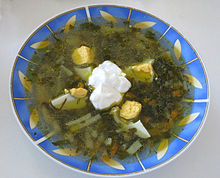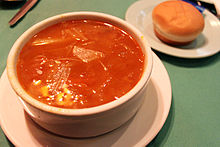Draft:Slavic sour soups
Slavic sour soups are common in Polish, Romanian, Armenian, Azerbaijani, Georgian and Moldovan cuisines, and examples are also found in other cuisines. They may be based on vegetables, grains, meats, fish, or dairy. Ukrainian beet-based borscht is an example.
Variants[edit]
Many soups in these culinary traditions are called borscht or similar-sounding names, but with sometimes wide variations in ingredients and preparation methods. The principal common trait among such soups is a tart flavor from sour-tasting ingredients.[1] The sour flavor may come from fermentation or from sour or tart ingredients.
In Polish cuisine, white borscht (barszcz biały, also known as żur or żurek, 'sour soup'[a]) is made from a fermented mixture of rye flour or oatmeal and water. It is typically flavored with garlic and marjoram, and served over eggs and boiled fresh sausage; the water in which the sausage was boiled is often used instead of meat stock.[3]

In the Carpathian Mountains of southern Poland, the tart taste comes from dairy products, such as whey or buttermilk.[4]
Sour soups that contain animal (usually poultry) blood mixed with vinegar is dark brownish-gray in color and are termed "gray borscht" (barszcz szary), which is a regional name of the Polish blood soup better known as czernina.[5]

Green borscht (zeleny borshch[b]), a light soup made from leaf vegetables, is an example common in Ukrainian and Russian cuisines. The naturally tart-tasting sorrel is most commonly used, but spinach, chard, nettle, garden orache and occasionally dandelion, goutweed or ramsons, may be added as well, especially after the spring season for sorrel has passed.[6][7][8][9] Like beetroot borscht, it is based on meat or vegetable broth and is typically served with boiled potatoes and hard-boiled eggs, sprinkled with dill.[10] There is also a variety of Ukrainian green borscht which includes both sorrel and beetroots.[11]
In Romanian and Moldovan cuisines, a mixture of wheat bran or cornmeal with water that has been left to ferment, similar to, but less cloudy than that used in Polish white borscht, is called borș.[12][13] It is used to impart a sour taste to a variety of tangy Romanian soups, known as either also borș or ciorbă. Variants include ciorbă de perișoare (with meatballs), ciorbă de burtă (with tripe), borș de pește (with fish) and borș de sfeclă roșie (with beetroots).[14][15]

The Armenian, Azerbaijani and Georgian version of borscht is a hot soup made with beef stock, green peppers and other vegetables, which may or may not include beetroots, and flavored with chopped red chili and fresh cilantro.[16][17] In ethnic Mennonite cuisine, borscht refers to a whole range of seasonal vegetable soups based on beef or chicken stock – from spring borscht made with spinach, sorrel and chard to summer borscht with cabbage, tomatoes, maize and squash to fall and winter borscht with cabbage, beets and potatoes.[18]
In Chinese cuisine, a soup known as Luosong tang,[c] or "Russian soup", is based on red cabbage and tomatoes, and lacks beetroots altogether; also known as "Chinese borscht", it originated in Harbin, close to the Russian border in northeast China, and has spread as far as Hong Kong.[19] In Shanghai's Haipai cuisine, tomatoes are the main ingredient; beef and its broth, onions and cabbages are also added; while flour, rather than sour cream, is used for thickening.[20]
See also[edit]
Notes[edit]
- ^ Polish terms barszcz biały 'white borscht' and żur or żurek are either used interchangeably or refer to different soups, depending on the regional dialect and ingredients used.[2]
- ^ Russian: зелёный борщ (zelyony borshch); Ukrainian: зелений борщ (zelenyi borshch).
- ^ In the Chinese simplified script: 罗宋汤.
References[edit]
- ^ Burlakoff (2013), Chapter 2.
- ^ Żmigrodzki, "biały barszcz".
- ^ Strybel & Strybel (2005), p. 193.
- ^ Szymanderska (2010), pp. 454–455.
- ^ Gloger (1900), p. 307 (vol. 3), "Jucha".
- ^ Łuczaj (2012), p. 21.
- ^ Artyukh (1977), p. 55.
- ^ Gurko, Chakvin & Kasperovich (2010), p. 78.
- ^ Guboglo & Simchenko (1992), p. 98.
- ^ Burlakoff (2013), Appendix.
- ^ Kulinariya, p. 792.
- ^ Gal (2003), "Borș".
- ^ Reid & Pettersen (2007), p. 52.
- ^ Rennon (2007), p. 53.
- ^ Auzias & Labourdette (2012), p. 77.
- ^ Petrosian & Underwood (2006), pp. 107–108.
- ^ Hercules (2017).
- ^ Fertig (2011), pp. 128–129.
- ^ Burlakoff (2013), Chapters 3 and 8.
- ^ Zhou & Sun (2012).
Reference works[edit]
- Auzias, Dominique; Labourdette, Jean-Paul (2012). Roumanie 2012–2013 [Romania 2012–2013] (in French). Paris: Petit Futé. ISBN 978-2-7469-6376-4.
- Barber, Katherine, ed. (2004). The Canadian Oxford Dictionary (2nd ed.). Oxford University Press. doi:10.1093/acref/9780195418163.001.0001. ISBN 978-0-19-541816-3. Retrieved 2016-12-23.
- Dal, Vladimir I. (1863–66). "Tolkovy slovar zhivogo velikorusskogo yazyka" Толковый словарь живого великорусского языка [Explanatory Dictionary of the Living Great Russian Language]. Akademik (in Russian). Sankt-Petersburg: Obshchestvo lyubiteley rossiyskoy slovesnosti. Retrieved 2015-08-02.
- Davidson, Alan (2014) [1999]. "Kisel". In Davidson, Alan; Jaine, Tom (eds.). The Oxford Companion to Food (3rd ed.). Oxford University Press. doi:10.1093/acref/9780199677337.001.0001. ISBN 9780199677337. Retrieved 2016-12-23.
- "Dictionary.com Unabridged". Random House. Retrieved 2015-05-20.
- Doroszewski, Witold, ed. (1969). "Słownik Języka Polskiego" [Polish Dictionary] (in Polish). Warszawa: Państwowe Wydawnictwo Naukowe.
- "Encyclopædia Britannica Online". Encyclopædia Britannica Inc. Retrieved 2015-05-20.
- Gal, A.M. (2003). "Dicționar gastronomic explicativ" [Explanatory Culinary Dictionary] (in Romanian). Editura Gemma Print.
- Gloger, Zygmunt (1900). Encyklopedja Staropolska [Old Polish Encyclopedia] (in Polish). Warszawa: P. Laskauer i W. Babicki.
- Harper, Douglas. "Online Etymology Dictionary". Retrieved 2015-05-20.
- Hirsch, Emil G.; Benzinger, Immanuel; Jacobs, Joseph; Harris, Isidore; Fishberg, Bertha; Dobsevage, I. George (1906). "Cookery". Jewish Encyclopedia. New York: Funk & Wagnalls Co. pp. 254–257. LCCN 16014703.
- King, David C. (2006). Azerbaijan. Cultures of the World. New York: Marshall Cavendish. p. 123. ISBN 0-7614-2011-8.
- MacVeigh, Jeremy (2008). International Cuisine. Clifton Park, NY: Cengage Learning. ISBN 978-1-111-79970-0.
- Mallory, J.P.; Adams, D.Q. (2006). The Oxford Introduction to Proto-Indo-European and the Proto-Indo-European World. Oxford University Press. ISBN 978-0-19-929668-2.
- Marks, Gil (1999). The World of Jewish Cooking. Simon & Schuster. ISBN 978-0-684-83559-4.
- Marks, Gil (2010). Encyclopedia of Jewish Food. Hoboken: John Wiley & Sons. ISBN 978-0-470-39130-3.
- "Merriam-Webster's Word Central". Retrieved 2016-02-17.
- Mish, Frederick C. (2004). Merriam-Webster's Collegiate Dictionary (11th ed.).
- Neilson, William Allan; Knott, Thomas A.; Carhart, Paul W. (1947) [1934]. Webster's New International Dictionary (2nd ed.).
- "Prykazky ta pryslivia pro yizhu" Приказки та прислів`я про їжу [Sayings and proverbs about food]. Vislovi (in Ukrainian). Archived from the original on 2017-10-12. Retrieved 2017-10-07.
- Reid, Robert; Pettersen, Leif (2007). Romania & Moldova. Lonely Planet. ISBN 978-1-74104-478-2.
- Rennon, Rosemary K. (2007). Language and Travel Guide to Romania. New York: Hippocrene Books. ISBN 978-0-7818-1150-7.
- Rudnyc'kyj, Jaroslav B. (1972). An Etymological Dictionary of the Ukrainian Language. Winnipeg: Ukrainian Free Academy of Sciences. Retrieved 2015-05-20.
- Saberi, Philip; Saberi, Helen (2014) [1999]. "Borshch". In Davidson, Alan; Jaine, Tom (eds.). The Oxford Companion to Food (3rd ed.). Oxford University Press. doi:10.1093/acref/9780199677337.001.0001. ISBN 9780199677337. Retrieved 2016-12-23.
- The Visual Food Encyclopedia. Québec Amerique. 1996. ISBN 978-2-7644-0898-8.
- Trubachyov, Oleg, ed. (1987). Etimologichesky slovar slavyanskikh yazykov Этимологический словарь славянских языков [Etymological Dictionary of Slavic Languages] (in Russian). Moskva: Nauka.
- Vasmer, Maksimilian Romanovich (1973) [1958]. "Etimologichesky slovar russkogo yazyka" Этимологический словарь русского языка [Russian Etymological Dictionary]. Akademik (in Russian). Moskva: Progress.
- World and Its Peoples: Belarus, Russian Federation, and Ukraine. New York: Marshall Cavendish. 2010. ISBN 978-0-7614-7900-0.
- World and Its Peoples: Middle East, Western Asia and Northern Africa. New York: Marshall Cavendish. 2006. ISBN 978-0-7614-7571-2.
- Zdanovich, Leonid I. (2014). Bibliya povara ili entsiklopediya sovremennoy kukhni Библия повара или энциклопедия современной кухни [Chef's Bible, or Encyclopedia of Modern Cuisine] (in Russian). Noginsk: Osteon-Press. ISBN 978-5-00-064178-1.
- Żmigrodzki, Piotr (ed.). "Wielki Słownik Języka Polskiego" [The Great Polish Dictionary] (in Polish). Instytut Języka Polskiego PAN.
